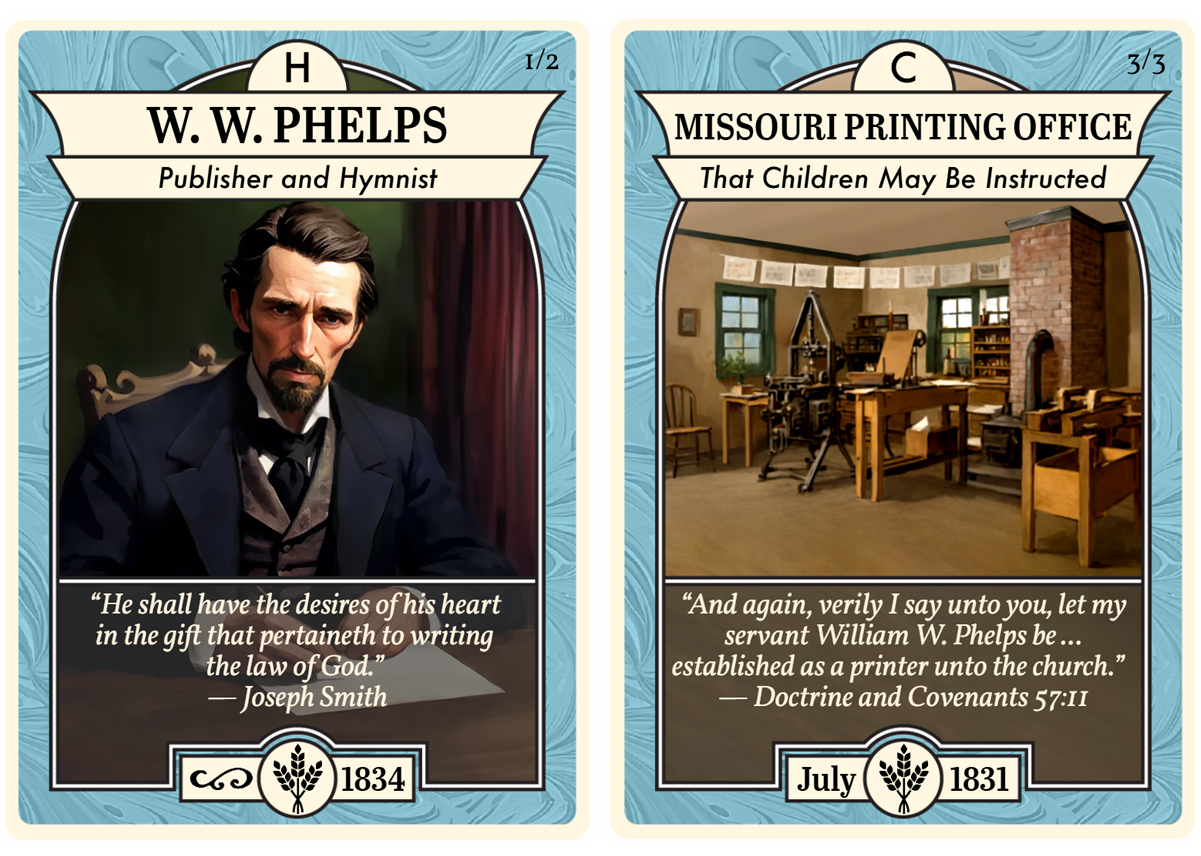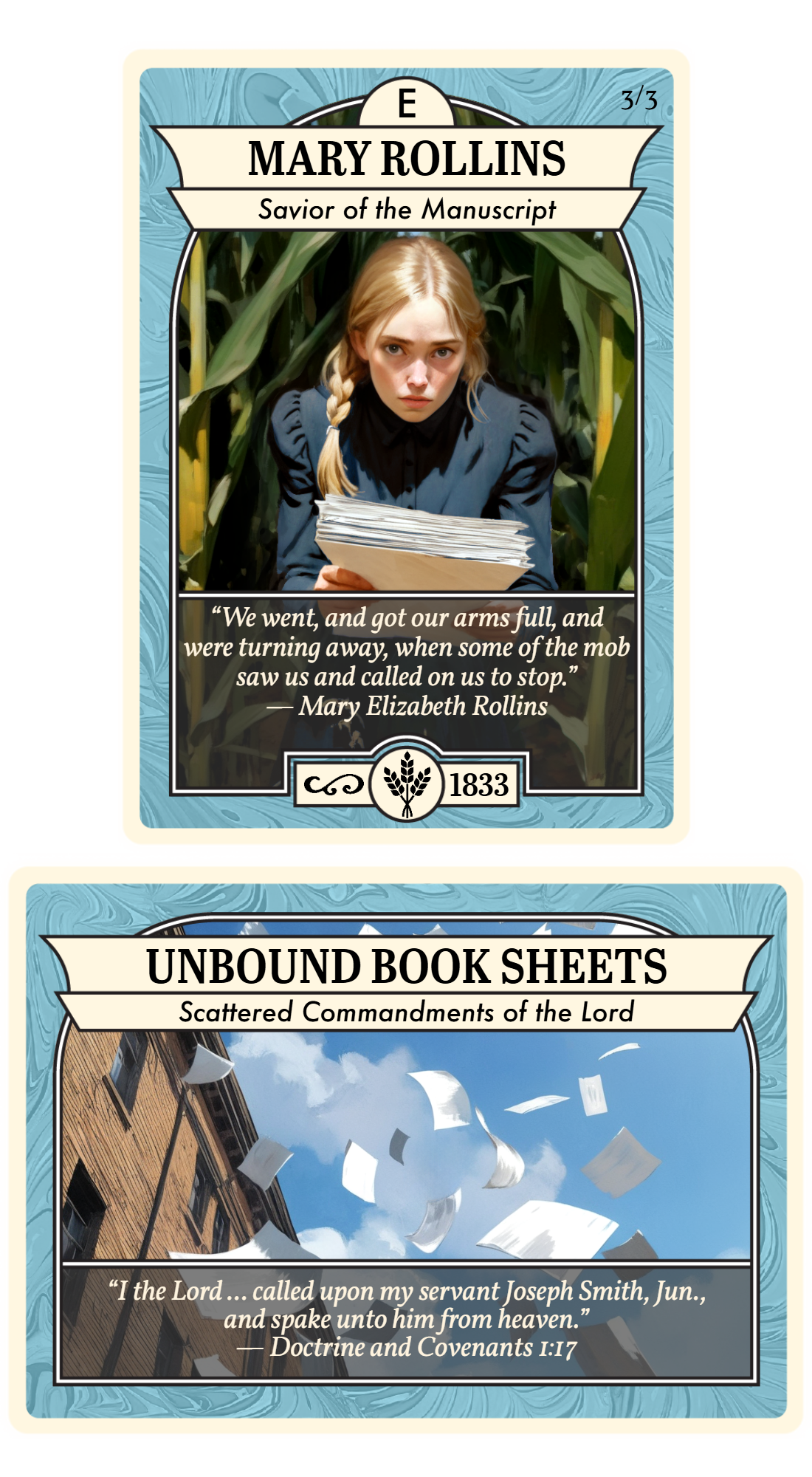When early Latter-day Saints arrived in Independence, Missouri, they came ready to build Zion. What they didn’t expect was how much of that Zion would be built on ink and paper.
Through revelation on July 20, 1831, the Lord gave one of the Church’s first mass media commandments: establish a printing press in Zion. Until then, the Saints had relied on handwritten copies of the revelations received by Joseph Smith. But now, the Lord wanted His word not just heard, but printed, preserved, and shared.
A Printer in Zion: W. W. Phelps and Missouri Printing Office

William Wines Phelps, a gifted writer and printer, received a divine call to establish the Church's first printing office in Independence, Missouri. As directed in Doctrine and Covenants 57:11, Phelps set up shop in a two-story brick building on Liberty Street—the westernmost printing operation in the United States at the time.
His press produced The Evening and the Morning Star, the Church's first newspaper, which helped teach doctrine and gather converts to Zion. But Phelps' most important assignment was printing the Book of Commandments, the first compilation of Joseph Smith's revelations. This sacred task would soon meet with violent resistance from Missouri mobs.
Publishing Revelation: Printing Commandments
![A historical trading card titled Printing Commandments – Publishing Glad Tidings, labeled “D” and numbered 2/2. It depicts a pair of hands holding an open copy of the Book of Commandments, published in 1833. The visible title page lists W. W. Phelps as the printer. The quote reads: “Search these commandments ... [for] the prophecies and promises which are in them shall all be fulfilled.” — Doctrine and Covenants 1:37. The card is marked 1831 at the bottom.](/cdn-cgi/image/f=auto,fit=scale-down,w=3840,h=1100/files/kq2zxk/img-52c26832-c679-479b-adab-d1f006db470d.png?t=eyJhbGciOiJkaXIiLCJlbmMiOiJBMjU2R0NNIn0..CnxU_7BokihQC4I8.xd6PllYrQCe-ZBsFH-3mAu45bEM8pRQHDFeQuJ6MgRcHkvULA2TfR422RZNUXRfpD4MFIKAahFr-JVBHZ7o8XOgM7qNWgIOFWQkXtpqlezoEHuN0L_TEqPtdD4poAcs0Z_sdJ2whB6i7OC2XjlChuwYJ3fLy39fbvBkkFvsW3MRXr3QjUl458c4g736Oi1cFDL0K3jlSBhRXzDT0lL8YS6dQtG_y-IJgrJ6fAV69D3fJzqU8arWU_tpveQ6ncBWORKT5rgsrBjMcZAvHd8ZCzeua52uNhprpv-OThaLhnGrq3c0K8_Ag8veRFOQ9Bdo9NqfdzumPQEQhanlEHcaFvTaRlJ_ZIC5OHOAv3ZDLz7r-B0ERiZr-uztgkNJRV4_xg4-CoyUtNziqE5DcerxBd7CPA0E.-ssOG_uqJUHZW4ImTVEvog)
In November 1831, Church leaders organized a committee including Phelps, Oliver Cowdery, and John Whitmer to select and prepare revelations for publication. The resulting Book of Commandments was meant to preserve and disseminate the word of God to Saints everywhere.
Printing began in earnest in 1832, with each page carefully typeset by hand. However, tensions in Missouri were rising, and on July 20, 1833, a mob stormed the printing office. They destroyed the press, scattered the type, and burned most of the unbound sheets.
A Bishop in Zion: Edward Partridge and Partridge Attacked
![wo Church History Cards depicting Edward Partridge. On the left, Edward Partridge – Like Unto Nathaniel of Old shows a dignified portrait of Partridge in formal early-19th-century attire, with the quote: “I have called my servant Edward Partridge; and I give a commandment, that he should be ... a bishop unto the church.” — Doctrine and Covenants 41:9. The year is 1831. On the right, Partridge Attacked – Steadfast in Tribulation depicts him covered in tar and feathers, kneeling on the ground after mob violence. The quote reads: “[They dragged] Bishop Partridge ... to the publick square ... and tared and feathered him from head to foot.” — Zion High Council. The date shown is July 1833.](/cdn-cgi/image/f=auto,fit=scale-down,w=3840,h=856/files/dN7DPf/img-6779a6d0-bc79-4c82-b0ee-371b33433a82.png?t=eyJhbGciOiJkaXIiLCJlbmMiOiJBMjU2R0NNIn0..t-tEilY328jBdGb_.aXO3ic47hojYzUSh4XcwqVHw36_KksPdCOMUnLGcpMz9aQdlfBxoQ7ZrUjYHjV1-C3APY2yMO79G0e4wLBPZ5ZqvWXKvZBXVjcViHoWdOKpyULhFTGDGOxS6v21i-dciutdgAXCWiMmctaME6X5EW_SdwWTdxYjru7fwCum-3g84NYD11mXVFZNu2VLJGU3pcLVc566Lr9Mk9KvRsfgXCLG_jXGUieVqWXSR91S9LwwXy3QHARZewMLwYsSSKG03lBeeJ3k-4qMnO1GZ0XAEkI26ozl0YtaQ33rZxgLjBNHIkPlz06NT9m5DbvwaysNDRsTYea7XYzpm9JNcep9Va9i7hL_9RBioC_S039EavgOpnzsiJZj2QLF1-IvMbmMruEVY7j6lZQiyQfxRWHb21Vh7bE4.S3FIK6OuYpzRUFowQapsyg)
Tensions between the Saints and local Missourians had been building for months. Many residents feared the Church’s growing political and religious influence and the talk of gathering thousands more to Zion. They were also alarmed by a publication from William Phelps that said the Church had "no special rule in the church as to people of color.” These fears, combined with economic concerns and deep-seated prejudice, boiled over into mob violence.
Bishop Edward Partridge, the Church's first bishop, was overseeing the Saints' settlement in Missouri when persecution erupted. A leader who had left his successful hat-making business to serve in the Church full-time, Partridge became a prime target for mob violence. On the day the printing office was attacked, Partridge was dragged to the town square, stripped of his coat and hat, and brutally tarred and feathered. Yet even as the mob demanded he leave the county, Partridge stood firm, declaring he would suffer for his religion as others had before him.
Saving the Manuscript: Mary Rollins and Unbound Book Sheets

Fifteen-year-old Mary Elizabeth Rollins and her sister Caroline witnessed the chaos of the printing office attack. Seeing sheets of the Book of Commandments scattered in the street, the sisters sprang into action. Dodging the rioters, they gathered armfuls of loose pages and fled to a cornfield to hide them.
"We ran as fast as we could," Mary later recalled.
Their quick thinking saved about 160 pages of revelations, enough to bind a few complete copies of the Book of Commandments. Just two years later, these same revelations, now expanded, would be published in Kirtland as the first edition of the Doctrine and Covenants. Learn more (and get your own set of cards) at churchhistorycards.com.
Bonus Trivia
*Answers in footnotes
1. What was the name of the Church’s Missouri newspaper, printed by W. W. Phelps?[1]
A. The Times and Seasons B. The Independence Reflector C. The Evening and the Morning Star D. The Ensign
2. Who was tarred and feathered along with Edward Partridge?[2]
A. Charles Allen B. Orson Pratt C. Newel K. Whitney D. David Whitmer
3. Where did Mary and Caroline hide the pages of the Book of Commandments when pursued by the mob?[3]
A. In a nearby house B. In a cornfield C. Under a bridge D. In a stable
4. In 1835, the Book of Commandments was eventually published as what book?[4]
A. Lectures on Faith B. The Pearl of Great Price C. The Doctrine and Covenants D. The Articles of Faith


